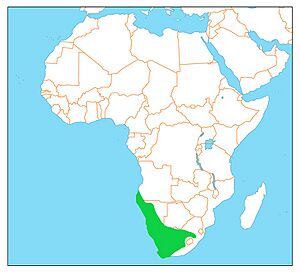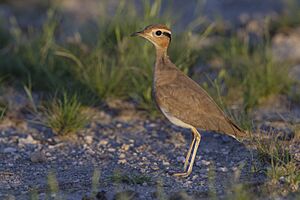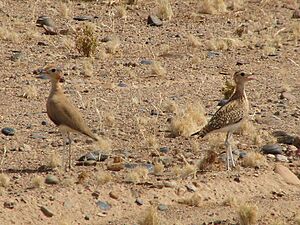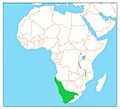Burchell's courser facts for kids
Quick facts for kids Burchell's courser |
|
|---|---|
 |
|
| C. rufus pair in Namibia | |
| Conservation status | |
| Scientific classification | |
| Genus: |
Cursorius
|
| Species: |
rufus
|
 |
|
The Burchell's courser (scientific name: Cursorius rufus) is a cool bird that lives in dry, open areas of southern Africa. Even though it's called a wader, it doesn't really hang out near water. Instead, it loves deserts and grasslands!
This bird is named after an English scientist, William John Burchell. It's a small bird, active during the day, and spends most of its time on the ground. Burchell's coursers are great at running. They chase after insects, especially Harvester Termites, which are their favorite snack. They grow to about 22 cm tall and weigh around 75 grams.
Contents
What Does a Burchell's Courser Look Like?
The Burchell's courser is a graceful bird with a straight, upright way of standing. It has a special blue-grey color on the back of its head. This helps tell it apart from a similar bird called the Temminck's courser.
This bird has a pale reddish-brown body. It also has a black stripe across its belly, which separates its white tummy. Its face has white stripes above its eyes and black lines through them. These lines meet at the back of its neck, making a cool double 'V' shape.
When it flies, you can see its mostly white wing feathers. Its beak is long and curves downwards, and it's dark, just like its eyes. Its legs are a creamy white color. When flying, its feet stick out past its tail.
Both male and female Burchell's coursers look very similar. Young birds, called juveniles, don't have the reddish color or the face stripes. They are also spotted with black and beige, which helps them blend in. It can be tricky to spot a Burchell's courser because its colors help it hide perfectly in its dry home!
Where Do Burchell's Coursers Live?
Burchell's coursers are found only in Africa, mostly in warm, dry parts of Southern Africa. You can find them in most of South Africa and Namibia. They also live in parts of southwestern Angola and the Kalahari Basin in Botswana.
These birds love deserts or semi-deserts that have gravel instead of just sand. They also live in open grasslands with short grass, or areas where plants are sparse or have been burned.
Burchell's coursers are often called "nomads" because they move around a lot. They might travel to different places depending on how much rain falls, as this affects their food and water.
Even though there are still many Burchell's coursers, their numbers are slowly going down. This might be because their homes are being lost to farms. Also, some farming methods, like too much irrigation (watering crops) and using too many pesticides, can harm their habitat and food sources.
How Do Burchell's Coursers Behave?
Burchell's coursers have some interesting behaviors! Adult birds have a clever trick to protect their nests from predators. They pretend to be hurt or act like they are sitting on eggs somewhere else. This is called a "diversionary display." It makes predators chase them instead of finding the real nest.
Baby coursers are quite developed when they hatch. However, they can't handle the heat as well as adults. So, they need shade to stay cool and avoid getting too hot.
What Sounds Do They Make?
Burchell's coursers usually prefer to run away from danger rather than fly. They will only fly if they are really scared. These birds are usually quiet when they are on the ground. But when they fly, they become quite noisy! They make a loud sound called a flight call.
Scientists have identified a few different sounds they make:
- A throaty "chuk" sound when they take off.
- Some "chuk chuk" grunts while they are flying.
- A "contact call" that sounds like "kwirrt-kwirrt" or "kok-kok-kwich." This is how they talk to other coursers.
- If a predator is near, they might run away from their nest and make an alarm call to distract the predator.
What Do They Eat?
Burchell's coursers mainly eat insects. They use their long beaks to search the ground and dig up their prey. They are also fast runners and will chase insects to catch them.
They often eat beetles, especially a type called curculionidae beetles. But their favorite food is harvester termites (Hodotermes mossambicus). Termites can make up more than half of their diet when they are available! Burchell's coursers almost never eat seeds. The amount of rain each year affects how much food is available, which is why these birds travel around so much.
How Do They Have Babies?
Burchell's coursers sometimes gather in small flocks, but they are mostly solitary birds. They are also monogamous, meaning they stay with one partner.
They can breed all year round because they move to different places. However, they often lay eggs just before the wet season, usually between July and December.
A female Burchell's courser lays only two eggs at a time. She lays them directly on the ground. Sometimes, the eggs are surrounded by small rocks, dried plants, or even animal droppings. The eggs are oval-shaped and look black from a distance, but they are actually a light brown color with many dark spots. Both parents help to sit on the eggs to keep them warm until they hatch.
Images for kids
-
C. rufus pair in Namibia






